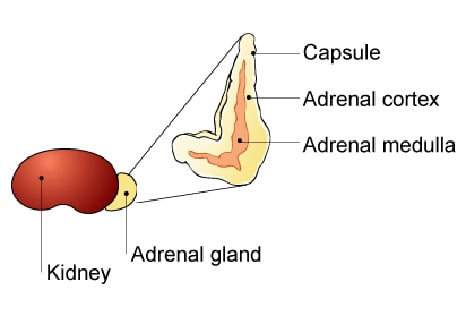What is the function of endocrine glands?
Endocrine glands produce specialized chemicals called "hormones". These regulate and integrate many activities to maintain internal stability of the body. The hormones pass directly into the blood to affect target cells elsewhere. The endocrine system includes the adrenal glands, thyroid gland, parathyroid gland, pituitary gland and specialized cells in the pancreas called the Islets of Langerhans. Some cells in other tissues throughout the body also produce certain hormones.
The pituitary gland at the base of the brain links to the other endocrine glands and regulates hormone production by the adrenals, thyroid and sexual organs as well as growth and the body's day-to-day cycles of activity (diurnal rhythm).
What are the adrenal glands?
The adrenals are a pair of distinct endocrine glands, located close to the kidneys.
Each adrenal gland has two parts. The outer part (cortex) is controlled by a hormone (adrenocorticotrophic hormone, ACTH) from the pituitary gland. The cortex produces steroid hormones of several types. One group acts with the kidney to control salt concentrations in the body, while a second group is the sex hormones. The 
The inner part (medulla) of the gland originates from the same cells that develop into the nervous system in the embryo. Therefore, it is not surprising that it produces neuroendocrine hormones with effects similar to those of the sympathetic nervous system.
What tumors occur in the adrenal cortex?
Tumors of the cortex of the adrenal glands may be hyperplasia (non-cancerous cell overgrowths) or cancers, either benign (non-spreading) or malignant (spreading). Usually they produce hormones that will have secondary clinical effects elsewhere in the body.
What do we know about the cause?
These tumors often develop after prolonged stimulation of the adrenal cortex. There is a continuous spectrum of abnormal change ranging from small areas of hyperplasia to benign and then malignant cancer. The stimulation may be due to overproduction of pituitary hormones that control the gland, or excess of these or similar hormones from an external source such as medicines or chemicals in the environment. Sometimes disruption of the natural regulation of hormone production ('feedback control') by the gland results in over-stimulation. Cancer induction is a multi-step process called 'tumor progression'. Some cancers never progress past the first stages so remain benign. Others progress rapidly.
Why has my pet developed this cancer?
Some animals have a greater tendency (genetic susceptibility) to cancer. Some breeds have far more cancers than others, often of specific types. In many cases, these tumors need prolonged stimulation to start growing and, sometimes, to enable them to persist.
Are these common tumors?
None of these tumors is common. Tumors of the pituitary gland, which produce the hormone (ACTH), results in over-stimulation of the adrenal cortex, leading to clinical signs associated with adrenal cortical hormone excess. Such pituitary tumors are more common than primary tumors of the adrenal itself.
In dogs, benign tumors of the adrenal cortex are the most common type...
In dogs, benign tumors of the adrenal cortex are the most common type and are seen in older animals. Adrenal tumors of all types are rare in cats.
How will these cancers affect my pet?
Clinical signs of primary pituitary tumors secondarily affecting the adrenal glands and of primary tumors of the adrenal cortex are the same. These signs include increased appetite and thirst, loss of hair, dry skin and "blackheads" on the belly. Some animals develop hard masses in the skin on the neck and back (from calcium deposits, a symptom called calcinosis cutis), which may ulcerate or become infected. The hormones cause redistribution of body fat and weakening of muscles, so the abdomen sags or appears "pot-bellied". The immune system is damaged so infections persist for longer than normal. Some dogs are also diabetic. Some tumors of the adrenal cortex produce excessive sex hormones. Malignant adrenal cancers may spread through the body by invading the adjacent blood vessels and seeding new tumors in body cavities and other organs.
 How are these cancers diagnosed?
How are these cancers diagnosed?
This type of cancer is often suspected based on the typical clinical signs. X-rays, ultrasound and MRI (magnetic resonance imaging) or CT (computerized tomography) scans may be useful in detecting the tumors, including metastases.
Blood tests help to identify functional tumors of the pituitary and adrenal cortex. However, to diagnose the tumor type precisely, it is necessary to examine the tumor itself. This involves exploratory surgery, often with total removal of the tumor. The tissue samples are submitted for microscopic examination using a diagnostic technique called histopathology. Specially prepared and stained tissue sections are made at a specialized laboratory where the slides will be examined by a veterinary pathologist.
The histopathology report typically includes words that indicate whether a tumor is 'benign' (non-spreading, local growth) or 'malignant' (capable of spreading to other body sites). These, together with the origin or type of tumor, the grade (degree of resemblance to normal cells or 'differentiation') and stage (how large it is and extent of spread) indicate how the cancer is likely to behave.
The veterinary pathologist usually adds a prognosis (what will probably happen). This may include information on local recurrence or metastasis (distant spread).
What types of treatment are available?
Primary adrenocortical tumors may be removed surgically or managed medically, depending on the individual case. Medical treatment, as for the pituitary tumors inducing secondary adrenal malfunction, is only successful if the cancer is still responding to pituitary hormones.
Can these cancers disappear without treatment?
It is not common, but the loss of blood supply to a cancer can make the cells die. Unfortunately, the disappearance of the cancer is rarely complete.
How can I nurse my pet?
After any surgery, you need to prevent your pet from interfering with the operation site and to keep it clean. Any loss of stitches or significant swelling or bleeding should be reported to your veterinarian. You may be asked to check that your pet can pass urine and feces or to give treatment to aid this. If you require additional advice on post-surgical care, please ask.
"Medical treatment of these tumors involves the use of toxic drugs so monitoring of your animal is essential."
Medical treatment of these tumors involves the use of toxic drugs so monitoring of your animal is essential. Good observation by you will enable this to be more accurate and improves the outlook because relapses are common. Please ensure you understand what you should check, how frequently and signs you should look out for.
How will I know how the cancer will behave?
Histopathology will give your veterinarian the diagnosis that also helps to indicate how a tumor is likely to behave. The veterinary pathologist usually adds a prognosis that describes the probability of local recurrence or metastasis (distant spread) for cancers.
Based on the specific diagnostic information that has been obtained for your pet, your veterinarian may be able to predict how the specific tumor in your animal is likely to respond to treatment and behave in the future.
When will I know if the cancer is permanently cured?
'Cured' has to be a guarded term in dealing with any cancer.
"But it is more probable that on-going medical treatment will be necessary."
Adrenal cortical tumors that can be treated surgically may be cured, but it is more probable that on-going medical treatment will be necessary. The treatment requires regular monitoring and life expectancy is variable from days to ten years and averaging less than three years. Because relapses are common, good observation by you, the owner, improves the outlook by catching relapses in their early stage. Deaths are due to problems associated with the original disease (e.g. heart failure, infection, pancreatic disease such as diabetes) rather than related to drug toxicity.
Are there any risks to my family or other pets?
No, these are not infectious tumors and are not transmitted from pet to pet or from pets to people.


